

People come to Florida today for many of the same reasons that the first settlers came in the 1800s. The warm climate is probably the most important factor. Northerners living in icy winter conditions get tired of shoveling snow, slipping on sidewalks, and getting their cars stuck in deep snow drifts.
The first Native Americans (or Prehistoric peoples) may have migrated to Florida to escape difficult living conditions too. This was eight to ten thousand years ago! Evidence of these peoples in our area is still visible through the remains of shell middens at Historic Spanish Point in Osprey.
Another reason people came to Florida was for the adventure and excitement of traveling in a new and exotic land or to improve their health. Imagine seeing alligators, panthers, snakes, and beautiful birds in the wild. Hunting these creatures was also part of the lure. One of the first settlers in our area came for these reasons, his name was William H. Whitaker.
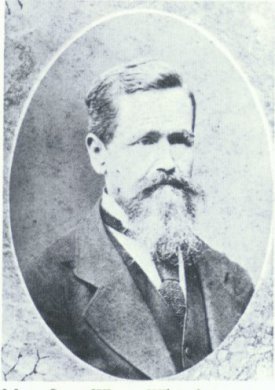
Bill Whitaker was 21 years old when he came to the Sarasota area in 1842. He had traveled
around Florida and to Key West, and even fought in the second Seminole War. With the war
just ended, and the land now considered safe for homesteaders, the United States Congress
passed the Armed Occupation Act of 1842. Those taking advantage of this act were given six
months' provisions and 160 acres of land, anywhere south of Palatka and Gainesville -
providing they were willing to defend their homes for five years. If additional land
was purchased, the going price that year was $1.25 an acre.
The migration to Florida had begun, and Bill Whitaker had found his "dream spot." In December of 1842 he sailed with his half-brother, Hamlin Snell, along the west coast south of Manatee until he found an excellent location. The land was high on yellow bluffs and overlooked Sarasota Bay. Fresh water was available in springs, and Indian kitchen middens and burial mounds were in evidence. A spot once chosen by natives would prove perfect for the Whitaker home site which was eventually called Yellow Bluffs. A beautiful bayou, or inlet, ran through the property and it is still known today as Whitaker Bayou.
The first Whitaker home was a crude, yet sturdy, cabin made of cedar logs floated over from Longboat Key where a large cedar forest then stood. Whitaker weathered two hurricanes in his log cabin. One in 1846 and one in 1848. The '48 storm was described by early settlers as "the granddaddy of all hurricanes." It was this storm which created a new opening through Longboat Key, and Whitaker named it New Pass. A name that remains to this day.
The first business venture started by Whitaker was the selling of dried salt mullet to the many Cuban traders who visited settlements along the coastline. Back then, the mullet were extremely plentiful in the bay and young Bill had no trouble in netting the fish and receiving one cent in payment for each. The money he made went into the purchase of some cattle which later became a large herd that grazed in the Myakka area.
The first orange grove planted in the Sarasota Bay/Manatee area is credited to Whitaker. He traded with the Cubans for the oranges they brought and then planted the seeds.
Bill Whitaker married Mary Jane Wyatt in 1851. Read the story of Mary Jane Whitaker by her grandson A.K. Whitaker. She was the daughter of Manatee pioneers Colonel William Wyatt and his wife Mary. In 1852, at Yellow Bluffs, the first white child was born in the Sarasota area. Her name was Nancy Catherine Stuart Whitaker. Nancy was their first child, but not the last, for the Whitakers had ten more children in the next fourteen years.
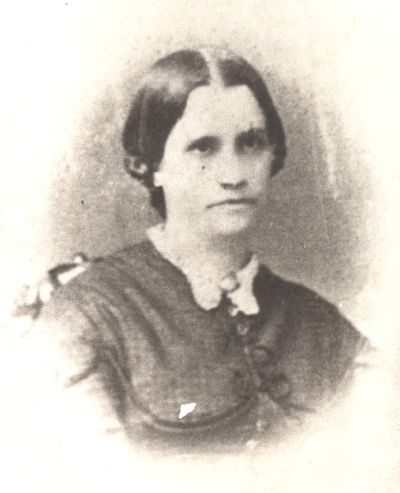
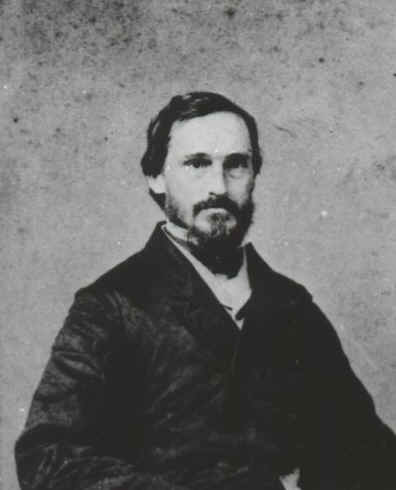 John and Eliza
Webb
John and Eliza
WebbFlorida's warm climate brought pioneers and adventurers from the north, and it also encouraged those with illnesses to journey southward. Persons suffering from lung diseases such as tuberculosis or asthma felt that warm temperatures were beneficial to their health. Some of the early homesteaders who traveled to Sarasota in 1867 for this reason were the family of John and Eliza Webb.
The Webbs resided in Utica, New York, which can be a cold and dreary place in the winter. Mrs. Webb had asthma and her doctor suggested a move south to improve her health. The Webb's had heard about the Sarasota area from a Federal soldier who had been in Florida during the Civil War. Many Union soldiers returning from the south extolled the land they had seen. They spoke of the beautiful vegetation such as oak, cypress, and palm trees, flowering shrubs, and fruit trees of orange, guava, papaya, and fig, and an abundance of fish and game. William Bartram, an adventurer during this era, described the game as"... bear, deer, turkeys, quail, and in winter season, geese, ducks, and other fowl."
But Florida had it's drawbacks as well. The early homesteaders were faced with the extreme heat of summer, swarms of insects, many snakes and alligators. The travel was difficult as there were few good roads and not many sailing vessels going between the few ports of call. Knowing of the challenges, yet eager to resettle, the Webbs and their five children, Jack, Will, Ann, Lizzie, and Ginny, plus Mrs. Webb's sister Emily Graves and her father, Deacon Graves set sail from New York in February of 1867.
The voyage to Key West lasted thirteen days and after some rough weather enroute, the family was happy to see sunshine and set foot on dry land. While in Key West they learned of a location near Sarasota Bay which would be a perfect homesite. The location was described to them by a Cuban fisherman who was familiar with the Gulf coast. The area included an ancient Indian burial mound, fresh water springs, and a high elevation to protect it from flooding.
The Webbs traveled on to Tampa,then to Manatee where they bought a small sloop and sailed the waters south of the Manatee settlement. With the help of Sarasota resident Bill Whitaker, who knew every inch of the local coastline, they found the spot that had been described to them. John Webb named the site Webb's Point. The name Spanish Point was also used in reference and thanks to the Cuban (Spanish) trader who described the place to them.
The Webbs first home was built with their own hands and was a rough pioneer dwelling. The outer walls of the cabin were constructed of logs and the roof was made of thatched palmetto. By this time, lumber was being milled in Manatee and the family purchased some of these boards to use for the interior walls. There was only one room with a divider. The women and children slept inside and the men slept in the outer area. At night the men had to be ready with their guns to defend the family from wild animals.
The work then began to clear the land and plant crops. The first garden consisted of sugar cane, peas, corn, squash, and sweet potatoes. Deer and wild turkeys invaded the growing crops on a daily basis. Keeping the troublesome pests out was a lot of effort, but it also meant there was an abundance of venison and turkey meat on the table.
Sugar cane became a major crop for the Webbs. They built a sugar mill to make syrup and sell it to residents in their growing community. They then built a refinery to produce sugar and it was known as the first "manufacturing plant" in what is today Sarasota County. Another first for the Webbs was operating a winter resort for tourists. See the guest book of the winter of 1898.
Florida was fast becoming a land of many attractions. Guidebooks were being published which told about this "idyllic" destination. Many of the people who ventured south were seeking opportunity in farming and agriculture, but there were those who came for the sport of hunting and fishing. One of these adventurers was G. O. Shields of Chicago.
Mr. Shields was an avid hunter and had heard of the abundance of wild game in Florida. He visited the Webb family on a journey throughout Florida. At this time, the Webbs had been in residence for twelve years. Shields described the land as, "... one of the most romantic and beautiful spots in the state, or, for that matter, in any state." Once in the house itself, Shields noted the view. "The windows on the north and south sides of the house command a beautiful view of the bay, and from those in the west end you may look across Sarasota Key and miles out upon the Gulf. Steamers and sail vessels may be seen almost any hour of the day." Tourism began slowly at the Webb home, but all who visited loved the climate, the hunting and fishing, and studying the site of ancient inhabitants. Many of the visitors decided to buy land and settle in the area.
The Webbs made many contributions to the community known as Sarasota and should be considered as one of the most influential families of the early pioneer homestead era. Today, evidence of their efforts can still be seen at the site known as Historic Spanish Point in Osprey. For over forty years the family farmed more than ten acres here. They shipped vegetables and citrus from their packing house, now rebuilt, to the markets in Key West and Cedar Key. Also on the site are: Mary's Chapel, named for a young woman who died while vacationing at the Webb's resort; the pioneer cemetery, where members of the Webb family are buried; the Guptill House, built originally by Frank and Lizzie Webb Guptill in 1901; and White Cottage, built by Jack Webb in 1884.
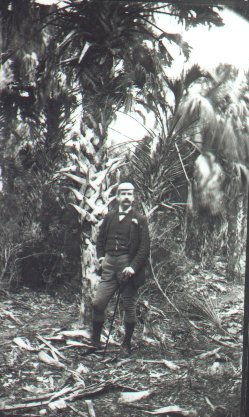
In the later 1800s it was not only settlers from other parts of North America who came to Florida. European residents also wanted to experience the sunshine and unlimited opportunity that was said to be available in this developing land.
In the British Isles, during the expansion of the British Empire throughout the world, times were difficult for the common people. Taxes were high to pay for the large Royal army and navy, and men were called to fight wars they all did not believe in. At this time to read of a place of orange and palm trees where the land was cheap and the soil was rich was very enticing to some. One of the men who took action to move to Florida with the aim of financial prosperity was John B. Browning of Paisley, Scotland.
Browning became involved with the Florida Mortgage and Investment Company, which was headed by John Gillespie of Edinburgh. Gillespie's company promoted forty acre estates" priced at one hundred pounds sterling in the beautiful town of Sarasota. Browning found all this too good to be true and he convinced his brother-in-law John Laurie to join him in this venture.
The Scots and their families met with other colonists in Glasgow and traveled on the steamship "Furnesia" to New York, arriving there on December 10, 1885. They reached their destination on Florida's west coast, Cedar Keys, on December 18 after a voyage to Fernandina Beach, and a train trip across the state. (Florida became a state in 1845)
After a lengthy delay, the Scots chartered a side-wheel steamer, "Governor Safford," to take them to Sarasota. This voyage, on December 28, 1885, was the first for any steam vessel to the settlement of Sarasota. The high expectations of the colonists were dashed as they viewed their new surroundings. There was no town, no streets, and no beautiful plantings. One of the few buildings was the company store which held very few supplies. Everything they had read about the new "town" of Sarasota was just that, a promotion on paper to encourage people to invest in the mortgage company.
The families already living in Sarasota were very helpful to the Scots, especially the Whitakers. Plenty of hard work followed, with land to be cleared, houses to be built, and roads to be made. Making things worse was the very cold winter that year, even snow was recorded. Some of the new arrivals couldn't endure the hardships and gave up and left. They had lost their money and their homes in Scotland. Many went to established towns in northern states to seek work and become resettled.
It appears that Gillespie was not completely at fault in promoting the development scheme. The original promoters,of a different organization known as the Florida Land and Improvement Company, convinced Gillespie and his friends that the region could make money for them. Eventually, some building and improvements took place, but the only family to remain of the Scottish colony was that of John Browning.
After a hotel, called the Sarasota House, was built in March of 1886, an early guest was John Hamilton Gillespie. He was the son of Sir John Gillespie and was sent to Sarasota to represent the interests of the Florida Mortgage and Investment Company. By now, the directors of the Scottish company had begun to right the problems of the newly founded colony. Gillespie, age 34, was educated at Oxford, and served with the British military. He was married and his wife accompanied him to Florida.
Gillespie was a man of action and at once had workers improving the main streets and completing construction projects already underway. He supervised the building of a "fine hotel," named the De Soto, to encourage wealthy tourists to visit the area. Fishing was still a main attraction used to get tourists interested in Sarasota, and this sport was highly promoted to northerners.
One of the great loves of J. Hamilton Gillespie, was golf. This Scottish sport, though highly popular in Scotland, was little known in Florida and Gillespie is probably the one man credited with introducing it to the state. The first practice course, in Sarasota, consisted of one fairway and two greens and was located off Main Street in a clearing in the woods. Later, Gillespie planned golf courses for Henry B. Plant at other Florida locations and in Havana, Cuba. Gillespie built a nine hole course with club house by 1905. It extended from Links Ave. eastward to the present Ringling Shopping Center.
Gillespie centered all his efforts in the growing town of Sarasota, and he helped finance the first schoolhouse. Unfortunately, the building boom came to a close and so did the prosperity of the town. Steamers stopped making calls to the port as there was no trade. The workers left to find other jobs, and as there was no industry, there was little enticement for people to move here. What was needed was transportation. Gillespie thought he had the answer - a railroad. It took five years to accomplish this task, and the resulting inaugural trip took place on May 16, 1892.
The first train, called the "Slow and Wobbly" by local residents, ran from the county seat in Bradenton to Sarasota. It was rarely on time, as it only departed when there was a sufficient load. The tracks were uneven and the wood-burning engine was unreliable. Breakdowns were frequent.
The "wobbly" train lasted just a few years, but Gillespie and others arranged for another railroad to come to Sarasota. This was the Seaboard Air Line Railway, and it made a big difference in the town's development.
It was decided to incorporate the village of Sarasota into a town in 1902 and J. Hamilton Gillespie was named the first mayor. Other jobs taken by Gillespie during his residency were, attorney, real estate agent, and justice of the peace.
On September 7, 1923, while on a golf course in Sarasota, Gillespie suffered a heart attack and died a few hours later. He was an important figure in the early development era of Sarasota and was also enthusiastic about the possibilities of the growing town.
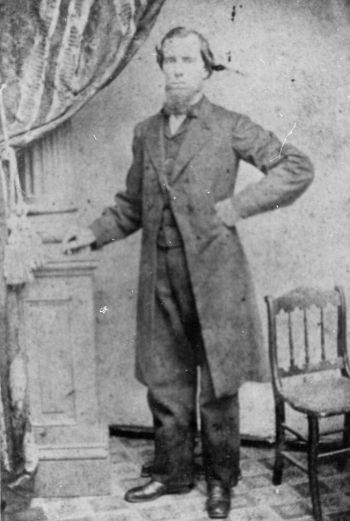 Some early
settlers who came to Florida in the 1800s had a clear picture of what they wanted to do to
make a living. They had a plan on how to execute their business and knew where they wanted
to locate. One of the entrepreneurs who chose the Sarasota area was Frank Higel of
Philadelphia.
Some early
settlers who came to Florida in the 1800s had a clear picture of what they wanted to do to
make a living. They had a plan on how to execute their business and knew where they wanted
to locate. One of the entrepreneurs who chose the Sarasota area was Frank Higel of
Philadelphia.
Higel was a chemist who had developed a process to extract starch from the roots of the cassava plant. (note: The cassava plant is a source of the starches arrowroot and tapioca.) He convinced a Philadelphia manufacturer, Hamilton Disston, of the value of his discovery and was granted the use of some land near Venice. (note: the name "Venice" was given by Higel some years after his arrival. It was derived from the many canals and waterways in the region, reminiscent of Venice, Italy.) All went well with the growing of the cassava crops for over a year. Disston then sent machinery by rail for the starch manufacturing process, and personally came to visit the site. Unfortunately, a very cold spell greeted him. The weather was terrible and the temperature dipped to below freezing. This frosty taste of the south was enough for Disston who felt the growing of crops could never be successful here.
Higel was not entirely defeated as he then went into the production of sugar cane syrup. This, and the making of citrus juices that had health claims, guava jellies and marmalades, proved a profitable venture for him and his family.
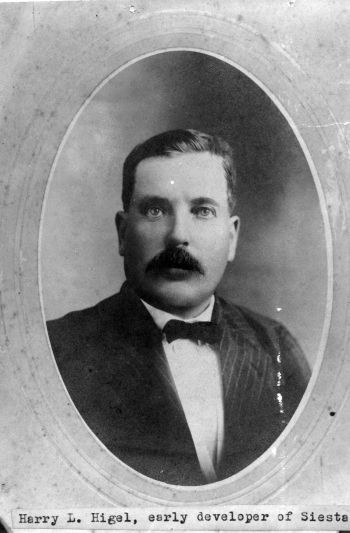 Harry Higel
Harry HigelFrank Higel had six sons: Frank, Jr., Harry L, Ralph, Eugene, George and Wesley. Of these men, George and Harry became prominent residents of the Venice-Sarasota region. Harry assumed many duties and has been credited with many contributions to the Sarasota community. Among these are: the gift of land in Sarasota for the first Methodist church, built in 1892 on the corner of Main and Pineapple streets; acted as the first agent for regular steamer service to Sarasota (the Mistletoe), and ran his own steamer (the Vandalia); helped to start the first telephone service; built the first building built to be a post office and telephone exchange; served as real estate sales agent for the Florida Mortgage and Investment Company; elected as councilmen of the first council of the incorporated town of Sarasota, recorded in 1902, with the town's motto, "May Sarasota Prosper;" in later years he became mayor, serving three terms; helped revive the Sarasota Yacht Club, and served as its first commodore; was one of the "good roads" supporters in the construction of better roads between Sarasota, Venice, Bee Ridge and Fruitville.
Perhaps the most memorable undertaking of Higel was the development of Sarasota Key. He named his subdivision "Siesta on the Gulf" and eventually advocated building a bridge to the barrier island's northern tip. The name "Siesta" was later gradually applied to the whole key. He also built bath houses (small structures used to change clothes) on the beach, and a hotel, named the Higelhurst in 1914-15. Unfortunately, this hotel burned down just a few years later in 1917.
Harry Higel married Gertrude Edmondson on January 18, 1896. She was the granddaughter of Mr. and Mrs. William Whitaker, credited as the first permanent settlers of the Sarasota region. A man of vision and positive action, Harry Higel is credited as one of the most progressive citizens in Sarasota's history. Tragedy struck in January, 1921, when Higel was found unconscious on Beach Road on Siesta Key. He had been brutally attacked and died while being transported to a hospital in Tampa. Rube Allyn, former editor of the Sarasota Sun newspaper was arrested. He had been in bitter disagreements with Higel, and was known for fierce outbursts of temper. Held in the Bradenton jail for 61 days, Allyn was released as all the evidence was circumstantial. The murderer of Higel was never brought to justice. Higel was laid to rest at the Rosemary Cemetery after the largest and grandest funeral the citizens of Sarasota had ever experienced.

The spirit of community was strong in almost all of the early settlers in Sarasota. People helped others in many ways, from financing new buildings, to pulling boats left high and dry on the beaches after storms. These acts were what made the growing town a success. Some Florida towns did not fare as well.
When necessity became an issue, there was always someone who would come forward with the ingenuity, the money, or the willpower to get the job done. In 1878 the need was for a post office. Until this time, residents had to retrieve their mail from the Whitaker home, which was a long trek for many. Acting mailmen were the Whitaker boys who brought the mail, not on a regular basis, from Manatee.
At this time, a resident named Charles E. Abbe, of Belvidere, Illinois, owned a home and a small store about a mile south of the road to Osprey. (Today the location would be on Osprey Avenue and Hillview.) He was also one of the largest landowners in the bay area. Citizens thought his store would be a perfect spot for a post office. Abbe was convinced of the need, applied to the government and received permission to open the first post office. It was known as the Sara Sota office with Abbe acting as the first postmaster.
During the Christmas season of 1884, Charles Abbe was murdered. His death, and several others, shocked the community. It was determined that the crimes were committed by members of a vigilante gang. Vigilantes were people who took the law into their own hands, without regard for what was right or wrong. See these photos of the murder area and telegram to her sister Caroline by Nellie Abbe about the murder.
Over a period of months, the outlaws were arrested and tried for their crimes. It was an unpleasant time in the history of Sarasota. To this day there are differing theories as to why the vigilantes committed these cold-blooded murders.

One of the most influential individuals, certainly the most
influential woman, to make an impact on the Sarasota region was Bertha Honore Palmer of
Chicago, the wife of financier and developer, Potter Palmer, who died in 1902.
In the winter of 1910 the internationally known socialite came to Sarasota after
reading an
advertisement placed by the local real estate firm of Lord & Edwards in a Chicago
newspaper.
The advertised area was described as the wondrous Sarasota region where tracts
of land could be purchased at low prices and the weather was beautiful all year. An astute
businesswoman, Bertha Palmer at once made arrangements to see the area for herself and
explore the possibilities for investment. Mrs. Palmer was sixty-one years old at the time
and had enjoyed years of influence at home and abroad. She socialized with the crowned
heads of Europe and had homes in London and Paris.
Mrs. Palmer arrived in Sarasota on February 10 with her two sons, Honore and Potter Palmer, Jr. She was also accompanied by her father, H. H. Honore, and her brother, Adrian C. Honore. Her first impressions of Sarasota included the phrase, "refreshingly quaint."
During this first visit to Sarasota, Mrs. Palmer was taken down Little Sarasota Bay in a launch captained by William Hodges. She was very attracted to the land at this location with its palm-lined view of the bay. At that time she decided to purchase the property as a site for her winter home. For the existing house, owned by the Lawrence Jones family, and 13 acres of land, Mrs. Palmer paid $11,000. She also purchased 200 acres of adjoining land. The name she chose for her land was "Osprey Point" which included present day Historic Spanish Point. She later built her home, "The Oaks," (interior shots of home 1, 2)on this land.
After her first investment, Mrs. Palmer purchased other land and acquired more than 80,000
acres of wetlands, orange groves, and pine forests in the Sarasota and Hillsborough County
areas. From 1910 to 1918 her Sarasota-Venice Company
controlled the investments and sold small tracts of land to settlers. Mrs. Palmer also
established a cattle operation at her ranch, called "Meadow Sweet Pastures,"
where she introduced innovations in the raising of pure bred cattle. After her death, a
portion of her property was donated by her sons to the State in her memory. This land is
known as Myakka River State Park and is Florida's largest state park. Through the vision
of Bertha Honore Palmer, Sarasota began to develop from a sleepy village to a vibrant and
competitive town. Her influence with business associates and friends brought many wealthy
investors to the area and helped considerably to develop the community. Mrs. Palmer died
on May 5, 1918 at her home, "The Oaks," after a short illness.
Of the early homesteaders who settled in the area known as Horse and Chaise, (now the Nokomis and Venice area), the Blackburns were among the most successful. John Slemans Blackburn was a farmer and cattle broker from Iowa. He came to the south Sarasota area and settled there in August 1881 with his wife, Belinda Fields Blackburn, and a son, George Washington Blackburn, who was fifteen years old at the time.
A new friend, Jack Webb, the youngest son of the Webbs of Spanish Point, helped them build their first house, which was thatched with palmetto leaves. To get them started on farming, Jack also plowed a field for them. Later, a more suitable house was built with three downstairs rooms, an upper story with one room, a stone fireplace, and glass windows. It was reported to be worth $300.
John Blackburn was a hard worker and enjoyed the south bay area. He spent much time on his land and produced his first crop - potatoes. Later he cultivated sugar cane and bananas.
Blackburn was obviously a creative man who could build many things. He built his own sloop which helped with trading his produce at markets along the coast. He named this boat “Sea Turtle.” It was a wide vessel, and well-suited to the shallow waters of the bays. The boat was capable of carrying heavy loads, and his cargo included citrus, produce, hogs, chickens, fish, and cane syrup. To aid the expanding south bay area, Blackburn brought in lumber, hardware, and arriving guests.
Another son, Benjamin Franklin "Frank" Blackburn moved to Osprey in 1884 from his Iowa home. He arrived with his wife, Emma, and two children, Effie Elvira and Walter David. After the move, three more sons were born to Frank and Emma. The sons were Albert, Spencer Slemans, and Herbert Franklin. Emma proved to be dedicated to their new lifestyle and maintained a good home for her large family.
John Blackburn's son, George, was elected in 1902 as a councilman to the first Sarasota town council. As one of the town's first businessmen, he opened a store on the corner of Main and Palm selling hardware and supplies for fishermen and hunters. He also had a blacksmith shop and built wagons.

It has been noted that one of the more profitable enterprises taken on by the early Florida settlers was cattle ranching. Among the prominent ranchers was Samuel Knight. He was the patriarch of the Knight family who eventually homesteaded in the Sarasota area.
Knight senior kept his cattle on pastureland northeast of Fort Brooke (in the present-day region of Dade City - Brooksville). He was one of several men to make land claims under the Armed Occupation Act in an area they deemed suitable for cattle ranching. The animals these men raised were described as "a large breed, with broad horns and close hair...good breeders...not...highly valued for the dairy." William Whitaker of northern Sarasota purchased ten cows from this stock in 1847 and his brand became the number 47.
One of the reasons cattle ranching became so profitable was the demand for meat from Cuba. Florida cattlemen were often paid in Spanish doubloons - coins made from gold. The local cowboys tended large herds and were tough, self-reliant individuals. They became known as "crackers" from the sounds their whips would make as they herded the cattle from place to place.
Jesse, Samuel's son, and Caroline Knight moved to Sarasota near the property of the Webb family. They had been living in the Hillsborough County cattle region, known as Knight's Station. The Knights had fifteen children, seven boys and eight girls. While in residence south of Spanish Point Knight became known as Reverend Jesse Knight, however he was never ordained.
The Knight’s south bay home was located in what was then called Horse and Chaise (for the tree and foliage outline from the water that looked like a horse and carriage). This area is the present-day Nokomis and Venice area.
Jesse's brother Joel was also a cattleman who located further south near the Myakka River. The Knight family made significant contributions to the Venice area for many generations.
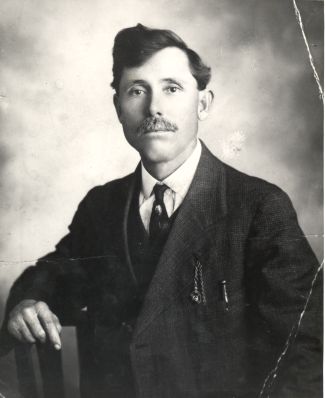
The Venice area became a popular residential spot for many early settlers. A well- known resident was John L. Edwards. The Edwards’ had seven children, five boys and two girls. Of these children, Arthur Britton Edwards became a very successful Sarasota resident who involved himself in a number of projects which helped the area grow.
A.B., as he was known, lost his parents before he turned fifteen and he cared for three of his younger brothers. He married Fannie F. Lowe and they had four daughters. In 1907 Edwards was elected the first tax assessor of the town of Sarasota. Also in 1907, Edwards was one of the original members of the Sarasota Yacht Club which was built on the north end of Siesta Key. At one point, Edwards became the first president of the Sarasota Citrus Association.
Because he, and many other Venice residents, wished to see more trade and growth come to the area, Edwards became an agent for acquiring the rights-of-way for the Seaboard Railway. This would provide a long-awaited rail connection to Venice.
Edwards helped establish the Lord and Edwards real estate firm which was the first real estate office in Sarasota. His company sold land to Mrs. Potter Palmer of Chicago. At the time, she paid $625 for a half interest in fifty acres. Edwards organized the Good Roads Committee with Harry Higel and Palmer real estate promoter, Lamar Rankin. One of their desires was to have a bridge go across the bay from mainland Sarasota. They also worked for a "permanent" road from Sarasota to Venice.
Perhaps the greatest honor bestowed on A.B. Edwards was that of first mayor for the newly-incorporated City of Sarasota on December 6, 1913. In the election he defeated his opponent William Worth by 45 votes. It is recorded that one of the first acts performed by the new city council was to prohibit persons from permitting chickens to run at large. This restriction followed the ban for hogs and cows to roam freely on city streets.
Although it may seem unimportant now, the early business of the new city and the vision of its leaders became important in promoting the growth and development of one of Florida's most beautiful areas.
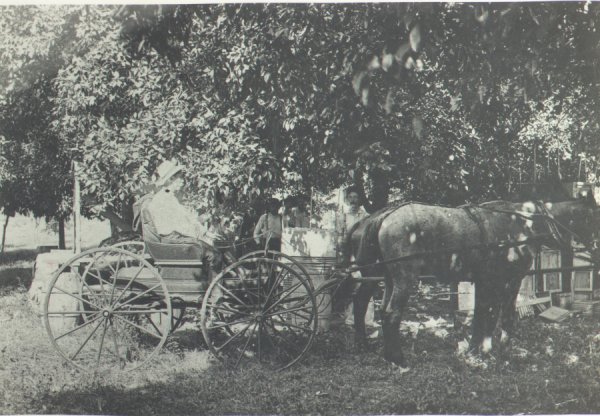
Living near the Gulf waters in the early settlement days provided the homesteaders with access to trade and the pleasure of travel and visitors. For those who settled inland, the going was tough, but the land provided a good living. One of the first farming communities in the Sarasota area was the settlement known as Miakka.
A prominent resident of Miakka was John Crowley. Crowley immigrated from Ireland to New York and moved to Florida in 1877. He married Sylvia Ann Carrier and they had three children, Adella, Charles Gustavas Lawrence and James Jeremiah.
As farming was the major occupation of most Miakka residents, the Crowleys farmed a substantial number of crops. They grew corn, rice, sugar cane, and sweet potatoes. Sweet potatoes were the main staple of these early farmers and they also used them as feed for livestock. Crowley would take ox-driven wagons to Oneco to sell their harvests as the railroad went there.
By trade, Crowley was a blacksmith. He made ironworks for wagons. The recreation of his blacksmith shop and cottage can still be viewed at the Crowley property today. The Crowleys also ran a saw mill. Life was not easy on the farm and each day was filled with hard work in order to survive. Housewives had to deal with food spoiling as there was no refrigeration and to be on guard for weevils in the flour or worms in the cane sugar.
One of the Crowley descendants, John Crowley, was the superintendent of the Myakka River State Park for over 17 years.
Newspaper Publisher
 Mr. and Mrs. C.
V. S. Wilson came to Sarasota from Manatee in 1899 to establish Sarasota's first
newspaper, The Sarasota Times. After her husband’s death in 1910, Rose Wilson
continued publication of the paper until 1923. Wilson was a community leader, and as
publisher and editor of Sarasota's only newspaper (with the exception 1913-1916, when Rube
Allyn published a second paper, the Sarasota Sun), she kept her readers informed of
local issues. While she reported all sides of a controversial issue, Wilson made clear her
position.
Mr. and Mrs. C.
V. S. Wilson came to Sarasota from Manatee in 1899 to establish Sarasota's first
newspaper, The Sarasota Times. After her husband’s death in 1910, Rose Wilson
continued publication of the paper until 1923. Wilson was a community leader, and as
publisher and editor of Sarasota's only newspaper (with the exception 1913-1916, when Rube
Allyn published a second paper, the Sarasota Sun), she kept her readers informed of
local issues. While she reported all sides of a controversial issue, Wilson made clear her
position.
Wilson was a founding member of the Town Improvement Society in 1903 and its successor, the Woman’s Club of Sarasota, in 1913. It was a time when women did not have the right to vote and women all over the country were influencing the character and development of their communities through the Woman’s Clubs. Wilson gave extensive press coverage to the activities of the Woman’s Club and often placed these articles on page one. She kept a scrapbook for the early years of the club and served as recording secretary for several terms.
Rose Wilson was an advocate for children. When, after area woman’s clubs had presented petitions to the January 1919 meeting of the county Board of Public Instruction for a compulsory school attendance law, and the Board agreed to call a referendum, Wilson noted in an endorsing editorial, "Every child has the right to an education." A compulsory attendance law was a "vital necessity" to guarantee that education.
Wilson was a strong supporter of the effort to give women the right to vote. In 1917 she took the affirmative side, and won, in a Woman’s Club debate on the merits of women’s suffrage. Beginning in August 1920, when the affirmative vote by the Tennessee Legislature assured the ratification of the nineteenth amendment to the Constitution, Wilson covered the issue weekly. In an early editorial, she urged women to understand the voting process so they could intelligently use their new power "for the good of the nation and the home."
The first two women to register to vote in Sarasota were Rose Wilson and Alice Guenther, president of the Woman's Club. The Times reminded women when the registration books would be open, and that they would be required to register in their given names. (Thus, Mrs. C.V.S. Wilson registered as Rose Phillips Wilson). The paper noted that while they could register for any party, women should realize that if they did not register as Democrats they would not be able to vote in the next local primary. (In 1920 the Democratic Party was the only party to nominate candidates for county offices.)
In the next two issues the paper gave front page coverage to a mass meeting held at the Woman's Club for the purpose of educating women about the registration and election process. All women were encouraged to attend. A reprint from the Tampa Tribune urged men to take advantage of such educational meetings or "the salvation of the country in the way of good government will rest with the women."
In the September 30th edition, the Supervisor of Elections reported that because of the high voter registration by women, he had appointed another deputy registration officer. Registration books would now be open every day but Sunday through October 9. The October 28 edition, the last before the election, listed all the candidates on the front page. The Democrats were marked with an "x." Since the presidential candidates were not listed, it was important for voters to know which presidential electors were associated with which candidate.
Election results headlined the November 4 issue of The Sarasota Times. Manatee County (of which Sarasota was still a part) and Sarasota experienced their largest voter turnout ever. There was no report on the number of women who voted or how that number compared with the number registered, but Rose Wilson can be credited with a major role in bringing Sarasota's women into the electoral process.
From the mid-1910s into the 1920s, a number of community leaders pulled together to improve the communities in the southern portion of Manatee County. They considered themselves the "progressives" and Rose Wilson counted herself among them. Issues of good roads, adequate schools, and political representation led, in the summer of 1920, to a call for separation from Manatee County for the areas between Sarasota, Englewood, and Myakka. Wilson carried full reports in the Times of the public meetings held to debate the issue and, after women gained the right to vote, urged women to attend the meetings to become well-informed voters. After the state legislature passed the bill to create Sarasota County, it was to Rose Wilson that the telegram was sent to announce their success. After a local referendum endorsed the split from Manatee, Wilson changed the name of her paper to The Sarasota County Times.
Wilson was active in area press circles. In 1914 she attended an organizational meeting of the South Florida Press Association and was elected treasurer. Three years later she presented a paper to the group, "A Woman’s Advantages and Disadvantages in the Newspaper Business." Shortly thereafter, the Tarpon Springs Leader ranked the Times as "the best weekly paper in the state." In her final column, after having sold the paper in 1923, Wilson acknowledged the loss she felt in giving up the professional relationships she shared with newspapermen and women around the state.
After 1923, Wilson moved from public leadership to a more private participation in Sarasota’s progress. She considered herself to have been a pioneer who "caught the vision and paved the way" for the new growth the 1920s land boom brought to Sarasota. She lived through that boom period, the depression, World War II, and Sarasota’s second boom period of the 1950s. Wilson continued her work with the Woman’s Club into the 1940s and devoted much time as teacher and mentor for youth at First Presbyterian Church. She died in 1964 at the age of 88.
Emma E. Booker
Teacher and Educational Leader in Sarasota's Black Community
 Emma Edwina Booker
(pictured on left with a friend) is one of the most instrumental and memorable women
in Sarasota history. Her legacy remains strong in the three schools in Sarasota County
that are named after her. They include Emma E. Booker Elementary, Booker Middle and Booker
High School. Emma came to Sarasota in 1910 at a time when education for blacks in Sarasota
was rare and at times non-existant. Blacks in Sarasota were not permitted to attend
formerly "white" schools, such as Sarasota High School and Bay Haven and
Southside Elementary Schools. They were taught to read out of a few very old books.
Usually family members and other members of the community would teach some of the students
lessons.
Emma Edwina Booker
(pictured on left with a friend) is one of the most instrumental and memorable women
in Sarasota history. Her legacy remains strong in the three schools in Sarasota County
that are named after her. They include Emma E. Booker Elementary, Booker Middle and Booker
High School. Emma came to Sarasota in 1910 at a time when education for blacks in Sarasota
was rare and at times non-existant. Blacks in Sarasota were not permitted to attend
formerly "white" schools, such as Sarasota High School and Bay Haven and
Southside Elementary Schools. They were taught to read out of a few very old books.
Usually family members and other members of the community would teach some of the students
lessons.
When Emma E. Booker came along, she was very instrumental in renting a hall and starting Sarasota Grammar School, so that black children would have a place to go to school. She became its first principal and taught several of the classes. In 1925 she led a procession of students and teachers from the old Knights of Pythias Hall to a new school built next to the railroad tracks at Lemon and Thirteenth Street ( now Seventh St.) by the Rosenwald Fund. This new school had four classrooms and an auditorium. Mrs. Booker inspired many of her students to continue their education and give back to their community: teachers, business people, nurses, and sports players.
She did not have a degree to teach, but continued to go to school, determined to finish college, regardless of all the obstacles that she had to overcome. After going to school for almost fifty years Emma finally earned her bachelor's degree.
Mrs. Booker taught in several other cities and towns as well, which included Live Oak, Lake City, DeLand and Daytona Beach. Her pay was between $25-50 a month!
Dr. Joseph Halton, M.D.
Sarasota’s First Physician and Humanitarian
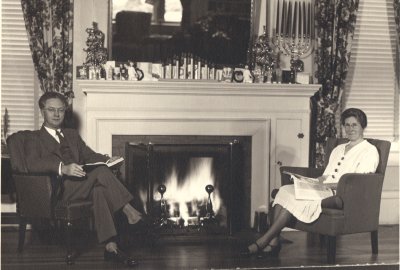
Seen here at home with his wife Peachy Halton
Dr. Joseph Halton was Sarasota’s first physician and he practiced medicine here for over 50 years, reaching near-legendary status during that period.
Dr. Halton was born in St. Helens, Lancashire, England on January 9, 1881. This was a small town near Liverpool. He arrived in the United States, with his family, as a boy of seven. His father emigrated to the US to become engaged in the glass manufacturing business. Dr. Halton grew up in Ohio and Indiana. As a boy, he worked for wages of 12 and a half cents an hour. Determined to better himself, he saved $130 to enroll in the Medical School at the University of Cincinnati.
It was right after graduation from Medical School that he arrived in Sarasota, in January of 1907. He came with his brother who was also a medical doctor. At the time Sarasota was a city of 1400 people. Dr. Halton was met at the depot by a Sarasota citizen who thought his mother was bleeding to death. Dr. Halton jumped into a boat with the man and headed out to Siesta Key, where he saved that woman’s life. This incident immediately helped to establish Dr. Halton’s reputation in Sarasota.
A year later, with the financial help of J. Hamilton Gillespie, one of Sarasota’s most prominent citizens, Dr. Joe and his brother, Dr. Jack, founded The Sanitarium at 300 North Gulfstream Avenue. It was Sarasota’s first hospital.
At the start, Dr. Halton made regular medical calls as far away as Bradenton and Venice with his horse and buggy.
"I’d make a call to one house out in the country, and before I could get away from there, a messenger would meet me and tell me to stop somewhere else while I was in the neighborhood. The calls built up like a snowball all the time I was on the road," Dr. Halton said.
When he first started his practice in Sarasota, Dr. Halton kept a stable of five horses. He drove two horses, hitched to a buggy, in order to get over the old sand roads. It took him about five hours to go from Sarasota to Venice on a call. Dr. Halton said that he could make better time on horseback on he could in a buggy. So, whenever he was advised that a baby was on the way, he rode the horse.
Later, Dr. Halton was one of the first Sarasotans to purchase an automobile, for which he paid $1200. The car was a Hudson. The year was 1910. He bought the car in Tampa because Sarasota had no car dealerships at that time.
During the early days of his practice in Sarasota, Dr. Halton said the territory he covered encompassed an area as large as the state of Delaware. Night calls were expected as part of his profession at that time and he made calls at all hours of the night.
"Why, I’d have one leg in my britches by the time I got the receiver off the hook." At the time there were only 14 telephones in all of Sarasota and all 14 phones were on a party line. As he put it, "With party lines, everyone knew everyone else’s business."
Some weeks Dr. Halton was on the road following his practice from Monday through Saturday without ever getting back to town.
In 1914, Dr. Halton was made chairman of the town council. During that period he tried to pass an ordinance to banish cattle from roaming the Sarasota streets. His action was not appreciated by the cattlemen of the town, especially because their cattle "watered" at the public water fountain at Five Points. (Now across the green from the Selby Public Library in downtown Sarasota.)
As a result of trying to pass this ordinance, Dr. Halton received mean hate mail and death threats. Dr. Halton sent the mail threats to Washington, DC and a federal marshal was soon appointed to protect him. He stayed by his side for months afterwards.
Years later, a patient told Dr. Halton that he had been selected by the cattlemen to murder Dr. Halton for disturbing the established practices of the cattle industry in Sarasota. But the patient said he never performed the murder "Because the womenfolk would not stand for it. They said Dr. Halton had saved too many lives!"
Dr. Halton’s Sanitorium, which he founded with his brother, eventually closed because Sarasota’s population base did not provide enough patients to make it a viable business. Dr. Joe humorously said, "I worked my way through the available customers in about 24 months!"
Later on, Dr. Halton established a 30-bed hospital complete with an operating room and other health care facilities. It was located on the second floor of the building at 41 South Pineapple Avenue. This hospital was a success and stayed in business for nearly 30 years.
Later on, when Sarasota’s first community hospital was built (now Sarasota Memorial Hospital), Dr. Halton donated much of his equipment to it. At that time, he still maintained his own clinic on State Street in downtown Sarasota. It had the reputation of being one of the best-equipped clinics anywhere on the Florida Gulf Coast.
During his years as a physician in Sarasota Dr. Halton performed many operations for free. During the years 1933 to 1951, he successfully performed, without charge, over 1600 operations for needy children and secured for them free hospitalization and nursing.
Dr. Halton’s wife was from Hartford, Connecticut and he returned there with her for a visit every summer. Through the years, he spent 47 summers there, taking post-graduate courses to keep abreast of his medical field.
A legend in his own time, Dr. Halton was made the first life member of the Florida Medical Association in 1957. He was selected Sarasota’s Citizen of the Year in 1951. His contribution to the welfare of Sarasota spanned a period of 51 years, from 1907 to 1958.
Dr. Halton was known as "A Doctor’s Doctor. He would say that he was "a generalized specialist" with his wry sense of humor. He was always in demand as a public speaker.
Dr. Halton died on June 17, 1963 at the age of 82 at his home at 308 Cocoanut Avenue (Pictured Below).

John D. MacDonald
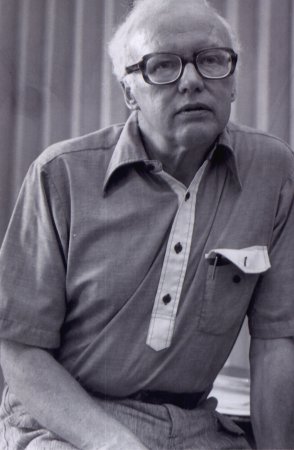
MacDonald came to the area in 1950. He was described as a thoughtful, generous man who was
very knowledgeable on many subjects. One of his chief concerns was for Florida's future.
He was an environmentalist and worried about uncontrolled growth in the State. His
thoughts on the subject were evident in his novel Condominium, written in 1977. The
story deals with a monster hurricane that strikes the coast of Florida. The book also
reveals practices of greedy real estate developers and corrupt
politicians.
MacDonald was an informal member of the "Liars Club," composed of a group of
resident writers and cartoonists who met weekly for lunch and to exchange information.
Among the attendees was his friend Dik Browne, creator of "Hagar the Horrible."
John MacDonald attended the Wharton School of Finance at the University of Pennsylvania.
He earned a degree in business from Syracuse University in 1938 and obtained a Master's
degree in 1939 from the Harvard Business School. His writing career started when he sent a
short story about India to his wife. At the time he was serving in World War II as an Army
Lieutenant in the China-Burma-India theater. His wife was so impressed with the story that
she sent it to a magazine where it was published.
During his many years as a writer, MacDonald wrote more than seventy-five novels on a
variety of subjects. Perhaps best known were his popular Travis McGee mystery series about
a detective living in Miami onboard his boat, "The Busted Flush."
He was at work on his twenty-second story in the collection when he died at age 70 in
1986.
The first novel written by MacDonald was a police story called The Brass Cupcake.
It was published in 1950. In 1958 his novel The Executioners became "Cape
Fear," a film starring Gregory Peck and Robert Mitchum. In 1984 director Victor Nunez
made a film from MacDonald's 1962 novel, A Flash of Green. Also in 1984 MacDonald
published his novel One More Sunday, dealing with the subject of television
evangelists for profit.
MacDonald said he wrote to entertain, and quoted movie industry giant, Sam Goldwyn, who
said it best: "If you want to send a message, call Western Union." MacDonald's
words were, "I just want to tell a good story." Tim Kantor, writer and son of
Mackinlay Kantor, described MacDonald as "a very disciplined writer and you could
tell from his novels that he had an enormous respect for the English language."
Thornton Utz

In a Saturday Evening Post article written by Mr. Utz he describes how he starts his work,"...the lighthearted beginning of my 'research' which, as every painter knows, aims to catch the subject simultaneously off guard and involved in something of personal interest, be it dreaming or tiptoeing through the grass barefoot. With Amy it was making mud pies."
Utz began his career as an illustrator and was commissioned to illustrate over 50
covers for the Saturday Evening Post magazine. (Another renowned illustrator for the same
magazine and its covers was Norman Rockwell.) In Sarasota, as well as painting, Utz has
produced sculptures and stained glass windows for the Church of the Incarnation. The
glass project took two years to design and complete. The stained glass was procured
in the United States and in Europe. Utz also designed the crucifix, ceramic panels
of the Stations of the Cross, and windows of the circular chapel of the church. The glass
scenes are bold in color and reflect a contemporary interpretation.
Utz has been compared to the artists who bridged the gap between fine art and commercial art. Among other notable Saturday Evening Post artists such as, Edward Hopper, Frederic Remington, William Glackens, William Sloane, Andrew Wyeth, and Grant Wood. Works by Utz hang in many private homes and public buildings. Much of his work seems to have been inspired by the natural beauty and sunlight of the Sarasota area.
Mackinlay Kantor
Pulitzer Prize Winning Author
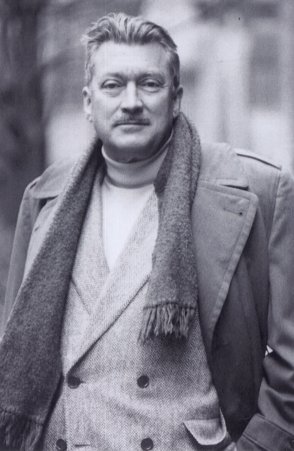
Mackinlay Kantor, author, novelist, and war correspondent greatly admired Sarasota and took up residence here with his family in 1936. Kantor lived in a large house overlooking the Gulf of Mexico on Siesta Key and was an active member of the community for 40 years.
He was born in Webster City, Iowa, in 1904 and attended Webster City Public Schools. During his lifetime he also lived in New York City, Hollywood, Spain and England.
He published his first novel, Diversey, in 1928, but the best known of Kantor's
works is Andersonville,
published in 1955. It is an historical novel about a Confederate Civil War prison camp
that was located in Alabama. The book contains more than 700 pages and took Kantor a
quarter of a century to write. The New York Times quoted the work as,
"prodigious and
profoundly moving." Columbia Pictures purchased the movie rights to the book for
$250,000. But the highest award for the work was winning the Pulitzer Prize in 1956.
Kantor felt that his early career as a newspaper reporter gave him good training as a writer. He started this career at age 17 and became a novelist at age 23. He was the author of more than forty books including verse, short stories, novellas, histories and books for children. He was author of the book from which the Academy Award picture was produced, "The Best Years of Our Lives."
His last book, Valley Forge, won him the Freedom's Foundation Award. It was the first time this award was granted to an author. When once asked about his writing, Kantor replied, "You have to put words on paper, a lot of them."
As a war correspondent (or reporter), Kantor flew with the Royal Air Force in World War II and with the 305th Bomb Group of the U.S. 8th Air Force. He also flew missions with the USAF during the Korean War. One of his most moving experiences during wartime was visiting the German prison camp, Buchenwald; a day after the U.S. captured it. The horror of this place stayed with him. Although he always had an interest in the Civil War, his own war experiences strongly influenced his writing of Andersonville.
Kantor married Irene Layne of Chicago and they were married for 50 years. Irene was an accomplished artist and active in local art organizations. He had an interest in the theater and enjoyed acting. The Kantors had two children, Layne and Tim. The family home on Shell Road was a favorite place for Kantor to write, play the guitar, cook, and have people visit. He never owned a television set, loved the open air (not air conditioning), and chopped wood for his fireplace.
Kantor was an avid writer of letters to the editor of the Sarasota Herald Tribune on matters pertaining to the community. At one point in 1956, he threatened to expose Sarasota County’s attitude toward its black children if it did not furnish them with a bathing beach. He also enjoyed meeting with fellow writers and founded the informal "Writers Group," which met for lunch every Friday at the Plaza Restaurant.
As a great admirer of Sarasota, Kantor was quoted as saying; "None of us will ever find a perfect existence on this planet. But I think that we in Sarasota have come as near to realizing it as anybody else. Life doesn't crowd us in Sarasota."
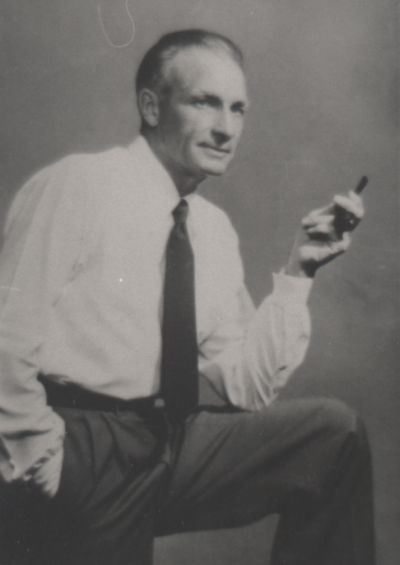
RALPH TWITCHELL
FOUNDER OF THE SARASOTA SCHOOL OF ARCHITECTURE
1890-1976
Born in 1890 in Mansfield, Ohio, Ralph Twitchell was interested in architecture from an early age. He first came to Florida in winter of 1903. Later, he and his family moved to Winter Park, Florida. His first visit to Sarasota was in 1908. He said of the town at that time, "Bradenton was quite a town then… but Sarasota hadn’t been born yet!"
Ralph studied at McGill University in Montreal, and then at Columbia University where he took courses in landscape architecture and the beaux arts form of architecture. In 1917 he enlisted in World War I and went to France where he learned to be a pilot. After an airplane crash, he came back to the US to recuperate. After the War, he designed several buildings in New York City.
A deeply spiritual and poetic man, Ralph Twitchell came to Sarasota as an architectural supervisor to architect Dwight Baum who was, at that time, building Ca’d’Zan, the John Ringling home. He then took part in the design and construction planning for the El Vernona Hotel, later known as the John Ringling Hotel. He built many homes in the Sarasota area. He built the tower in the Sarasota County complex on Main Street.
In 1926, Ralph designed four Mediterranean homes in the Whitfield area of Sarasota, north of the airport. In the summertime, Twitchell would take his family with him to Vermont and Connecticut where he built many beautiful country manor homes.
Many young architects came to Sarasota to work as apprentice architects underneath Ralph Twitchell. They came to learn his modern form of architecture. Architects like Paul Rudolph worked along with him. Rudolph later became the dean of the Yale School of Architecture and a prominent New York architect. Rudolph and Twitchell influenced other, younger architects such as: Gene Leedy, Jack West, Tim Seibert, Mark Hampton, Bill Rupp, Bert Brosmith and Carl Abbott. Victor Lundy and Frank Folsom Smith are also often included in the Sarasota School although they did not work with either Twitchell or Rudolph. The post W.W.II building boom gave these architects opportunities to build homes, churches, schools and other public buildings.
The Sarasota School of Architecture is really a regional answer to some of the principles of International style of architecture: that architecture is be harmony with its surroundings. Ralph Twitchell never thought that the Spanish, or Mediterranean style of architecture, really suited the Florida climate. His style of architecture, which he called Florida Modern, featured a clean, open contemporary floor plan. His homes were "goldfish bowls" – light-filled -- with terrazzo floors, wide overhangs, open to the beautiful Florida weather. Some people said he did more than anyone to integrate the beauty of Florida nature with architecture.
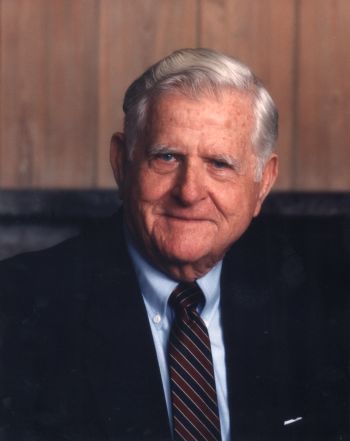 KEN THOMPSON
KEN THOMPSONKnown for his honesty, his integrity, friendship and the many ways he has helped our city grow, Ken Thompson has had more influence on the city of Sarasota than anyone since the Potters and the Ringlings. He was a true visionary for the city of Sarasota. He helped bring Sarasota from a small resort town to the modern city it is today.
Born of British heritage, a Scottish father and an Irish mother, on the American territorial island, Isle of Pines, in the Caribbean Sea., he lived in Cuba for several years where he learned Spanish. In 1922 he entered the United Stated via the Florida Key Railroad. He attended high school in Miami Beach where he was an excellent scholar in addition to earning varsity letters in football, baseball, basketball, and swimming.
Ken attended the University of Florida where he earned a degree in electrical engineering as well as three letters in baseball. Not satisfied with being just an electrical engineer, he took and passed the state examination for civil engineer and did the same for land surveyor. After college he worked in Miami Beach, l earning about city planning.
He was awarded a direct commission as second lieutenant in the Signal Corps and sent to both Harvard and MIT for six month's training at each in the field of advanced military electronics. After service in the Pacific during World War II, he returned to Miami Beach as city engineer and later, acting city manager.
Ken Thompson was hand picked to be Sarasota's second City Manager in 1950. He served as City Manager of Sarasota for 38 years, longer than any other city manager in the United States. He was instrumental in developing the Sarasota bayfront including Island Park, the Marina Jack development and boat marina. He was an expert in the science of beach preservation and a founding member of The Florida Shore and Beach Preservation Association. He was past president of The Florida City and County Managers Association. He was instrumental in fostering advanced waste-water treatment, leading the nation in using reverse osmosis methods.
A man of great vision, Ken Thompson helped to pave the way for the Van Wezel theater, the current City Hall, and a host of other developmental projects. He helped upgrade city services, especially in the area of the police force and the fire department. A fatherly-type person, Ken Thompson helped disadvantaged people in the city who needed friendship and a helping hand.
A multi-faceted person, Ken Thompson has had a long and fruitful career, helping our city grow into the Sarasota we know today. Sarasota became the community it is because he helped developed the environment and shaped it into the town we have today.
Ken Thompson has always had a keen interest in sailing and marine life. His boating interest helped tremendously to clean up the waters of Sarasota Bay. He would take City Commissioners in his little boat into the small bayous along the Bay and show them how our marine life was suffering, how the Bay was getting cloudy, and how it needed to be helped. He is known for his expertise on the trampoline, as well as his talent in his hobby of wire sculpture. He held a pilot license with instruments rating and loved to fly over and observe the bayshore and the city's growth.
He had received many government and civic awards and honors for his service as City Manager of Sarasota: Florida Senate, the Florida Engineering Society, Goodwill Industries' Distinguished Citizen of 1986, Fraternal Order of Police's Citizen of the Year, and Veterans of Foreign Wars' Man of the Year Award. Ken Thompson Park on City Island is named for him in honor of his many years of dedicated service to Sarasota.
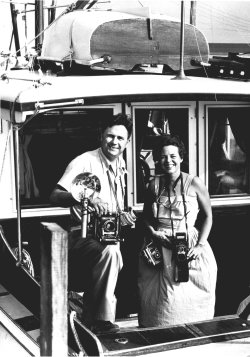 JOE STEINMETZ
JOE STEINMETZ
Photographer
(Pictured with his first wife Lois)
The unusual talent of Joseph Janney Steinmetz, the #1 professional photographer of Sarasota, was that he was considered to be a "photographic historian." From an early age, he documented the pursuit of social and leisure life in two privileged classes -- the wealthy of the Northeast and the middle class in Florida.
For more than half a century his cameras revealed the social history of a culture that is now all but past. He has often been called a "natural historian."
Born in Philadelphia's Germantown section in 1905, Steinmetz majored in English at Princeton University. On an around-the-world-trip in 1928, he picked up a Leica camera in Cairo. Back home, he began shooting candid photos at friends' weddings. He started on Philadelphia's Main Line doing deb parties, charity balls and formal teas as well as weddings. His first claim to fame was as the inventor of the the candid wedding album.
Starting with an invitation from the photo editor of the Saturday Evening Post, Steinmetz got his first magazine assignment to illustrate an article on "Baseball from the Bleachers." From there he went on to do cover assignments for Life, Time, Look, Holiday and other big national magazines.
Late in his career, he was selected as one of 15 major photographers whose work was chosen for an exhibition at Harvard's Department of Visual and Environmental Studies. He was featured in their show that illustrated how America's social rituals and lifestyles have been depicted by outstanding commercial photographers. Steinmetz commented: "My best images often have something to do with money, sunny and funny, particularly the last." He combined the innocence of a child with a sophisticated eye. When asked what makes a good photographer, Joe answered: "I always maintain curiosity about people -- about life. There's a picture in practically everything you see from the minute you wake up until you go to sleep."
Steinmetz was known for his 1945 series of photos at the Colony Beach and Tennis Resort where he shot a series of photos for the Florida Development Commission. The photos were 1950 classics, depicting families at the beach, dad barbecuing, family lifestyles centered around swimming pools in a stylized and somewhat "Camay" style. Casually dressed neighbors relax in aluminum lawn chairs. They have become classics of Florida in the 50's.
Steinmetz was a big fan of the Ringling circus. His favorite picture was a shot of famed clown Emmett Kelly sitting forlornly on a pile of paint-peeled circus wagon wheels at a trash dump at the Ringling Brothers winter quarters. In 1941 he traveled in John Ringling's private railroad car from Sarasota to New Jersey while completing a feature for Life Magazine. He continued photographing the circus for the next 20 years.
Steinmetz and his family first came to Sarasota in 1941 to escape the snow in Philadelphia and to help his brother, Bill, get over his habitual bouts of pneumonia. Steinmetz and his wife fell in love with Sarasota and built a cypress home on Crescent Beach on Siesta Key. Later on, they lived in Pelican Cove. His wife, Louise, was an accomplished oil painter. Steinmetz's lifelong hobby was magic. As he put it, "Life becomes boring without magic."
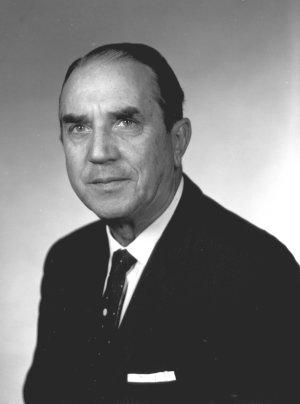 Verman
Kimbrough contributed to the town of Sarasota in many ways: college president, mayor,
school superintendent and caring and cultured citizen.
Verman
Kimbrough contributed to the town of Sarasota in many ways: college president, mayor,
school superintendent and caring and cultured citizen.
Verman was best known for being the president of Ringling School of Art and Design from its founding in 1933 until his retirement in 1971 -- a period of almost 40 years! Kimbrough persuaded John Ringling to buy the old Bay Haven Hotel and to back the startup of Ringling School of Art and Design in 1933. The school started out with 14 students. After its second year, the school swelled to 124 students. Thanks to Kimbrough's promotion, the school made its mark and has become a prestigious art school, recognized nationally.
Born in Rockford, Alabama, Kimbrough received his college degree in social sciences from Birmingham Southern College He also studied voice in New York and appeared in two shows on Broadway. He then went abroad to Italy and France for further voice studies and eventually made his operatic debut in Italy where he sang the baritone lead in Il Trovatore. A respiratory ailment and surgery left him with a chronic allergic condition that ended his professional singing career. He came to Sarasota by way of Florida Southern College where he taught sociology, psychology, and voice plus coached the school's last football team.
Verman Kimbrough guided the city toward building the Lido Beach Casino. He served as a mayor of Sarasota for one term and had to deal with the "Tin Can Tourists" who descended upon Sarasota in their caravans of trailers.
Kimbrough served as the superintendent of the Sarasota County School System starting in 1945 and handled those responsibilities until 1953. During his tenure, four new schools were built in Sarasota County.
Kimbrough was very active with The Players Theater, as one of its founders and finer performers. He helped with the Christmas and Easter programs for the Sarasota Choral Society. He also helped found the area educational television, WEDU, now our PBS station in Tampa. He was choir director and soloist at the First Presbyterian Church of Sarasota for 16 years. He served as a steward of the First United Methodist Church, and as a director of the Chamber of Commerce and the YMCA.
As a civic leader of Sarasota, Verman Kimbrough was a busy man. He always had a worthy cause, which included concerts for underprivileged children, the Salvation Army, the Cancer Society, the Florida West Coast Symphony and Happiness House. The library at Ringling School of Art and Design has been named in his honor.
ARLAND CHRIST-JANER
President of Ringling School of Art and Design, Civic Leader
 Arland
Christ-Janer came to Sarasota in 1973 to serve as president of New College, but his true
contribution to Sarasota was his work on behalf of Ringling School of Art and Design where
he served as president from 1984 to 1996 and again as interim president in 1998-99.
Arland
Christ-Janer came to Sarasota in 1973 to serve as president of New College, but his true
contribution to Sarasota was his work on behalf of Ringling School of Art and Design where
he served as president from 1984 to 1996 and again as interim president in 1998-99.
Arland Christ-Janer served as president of New College from 1973 to 1975 and engineered the merger between then-struggling New College and the University of South Florida. He also served as president of Boston University, of Stephens College in Missouri, of Cornell College in Iowa and as president of the College Entrance Examination Board in New York.
When Christ-Janer took the helm as president of Ringling School of Art and Design in 1984, the school had no endowment and many of its buildings were falling apart. Under his leadership and vision, the art school showed an impressive pattern of development. New Mediterranean-style buildings sprung up all over campus. The campus almost doubled in size. Ringling went from a 3-year program to a 4-year accredited program. During his tenure, the school became accredited by the National Association of School of Art and Design, which is the major accrediting agency for visual arts.
Credited with bringing a new sense of professionalism to Ringling, Christ-Janer raised an endowment well over a million dollars. The school began to receive over $400,000 in annual contributions. Students began to win scores of national competitions. The school opened a new major in Computer Animation in the late 1980s and began to attract a high level of professors from around the U.S. Foreign students began to come to Ringling in large numbers, and U.S. News & World Report named Ringling the Number 1 Up and Coming College in America. Truly, Christ-Janer put Ringling School of Art and Design on the map.
A native of Garland, Nebraska, Arland Christ-Janer grew up in an academic environment. His father was a parochial school teacher. One of his brothers was a dean at Pratt Institute in New York, and another brother taught at Columbia and Yale.
Christ-Janer left high school after his sophomore year to take courses at the University of Missouri. He obtained his BA degree from Minnesota's Carleton College. He then went on to obtain degrees from the Yale Divinity School and the University of Chicago Law School. While at Carleton College, he was very influenced by the school's president, Donald Cowling. He had transformed Carleton into a fine liberal arts college, and he demonstrated to Christ-Janer how satisfying a career as an administrator could be.
Very active in Sarasota, Christ-Janer served on many boards, including the New College Foundation, the Marie Selby Botanical Gardens and the Ringling Museum of Art. He served as chairman of the Sarasota Committee of 100 and on the economic development arm of the Sarasota Chamber of Commerce. His late wife, the former Sally Johnson Grice, was a hospital administrator and cellist. She joined her husband in many community events. Their legacy is the Sally and Arland Christ-Janer Scholarship Fund for Ringling School of Art and Design students. He has a studio where he constructs his geometric paintings and sculpture. Truly, Dr. Christ-Janer has been a Renaissance man for Sarasota.